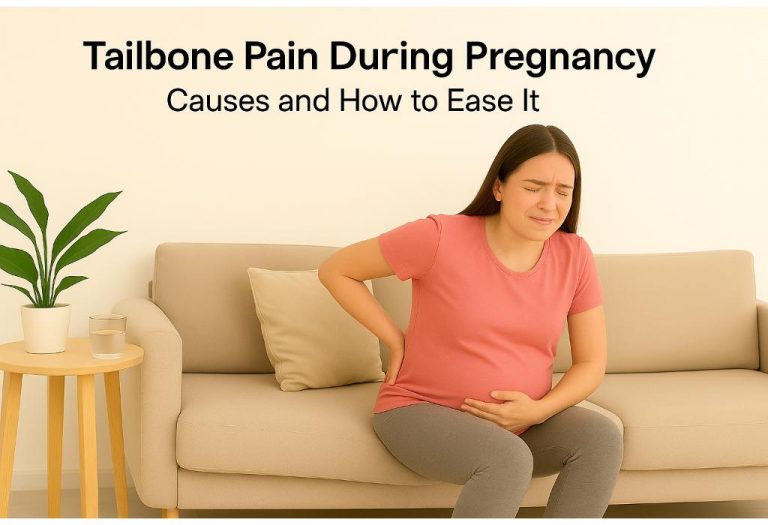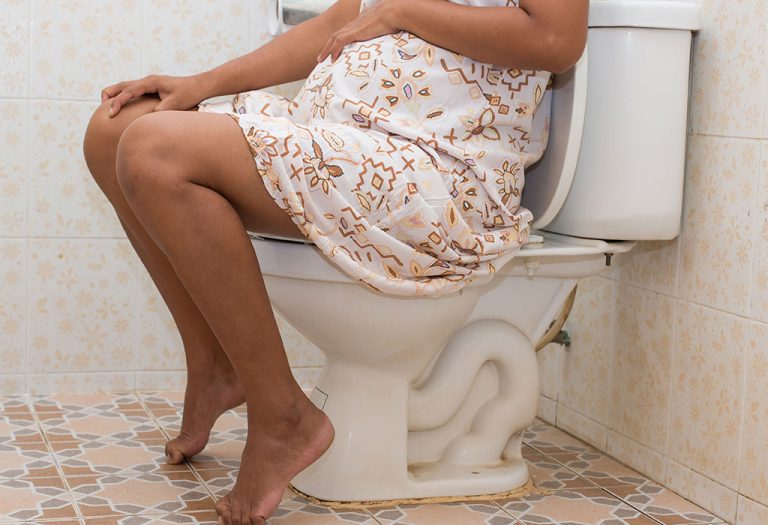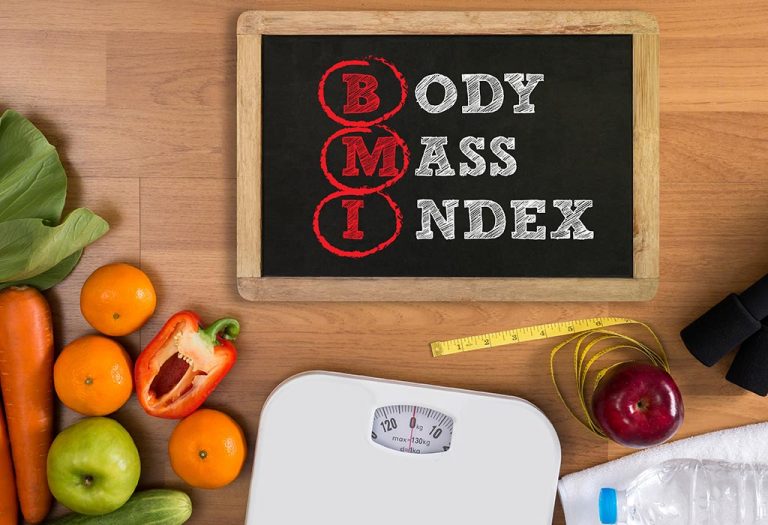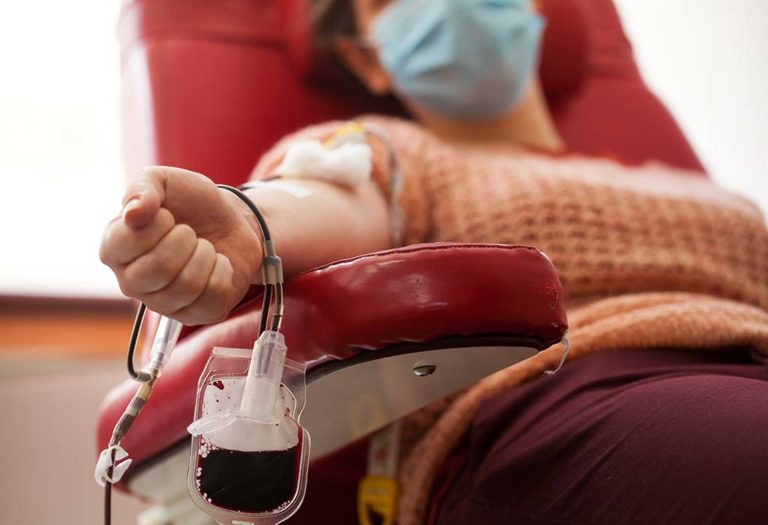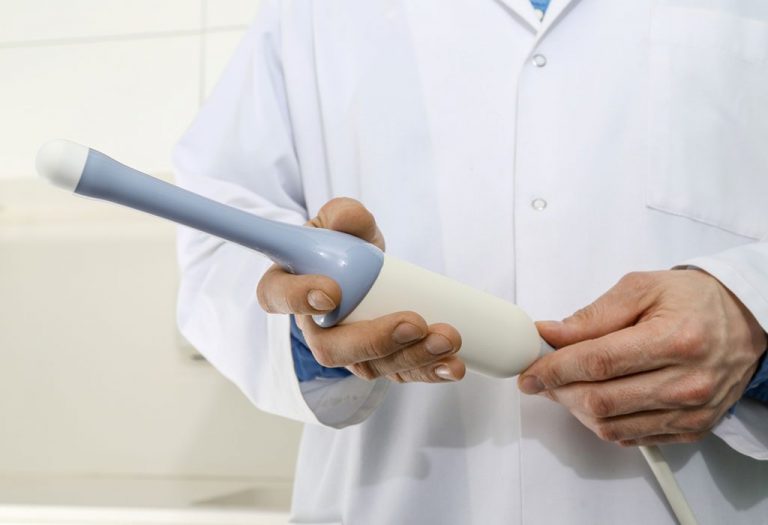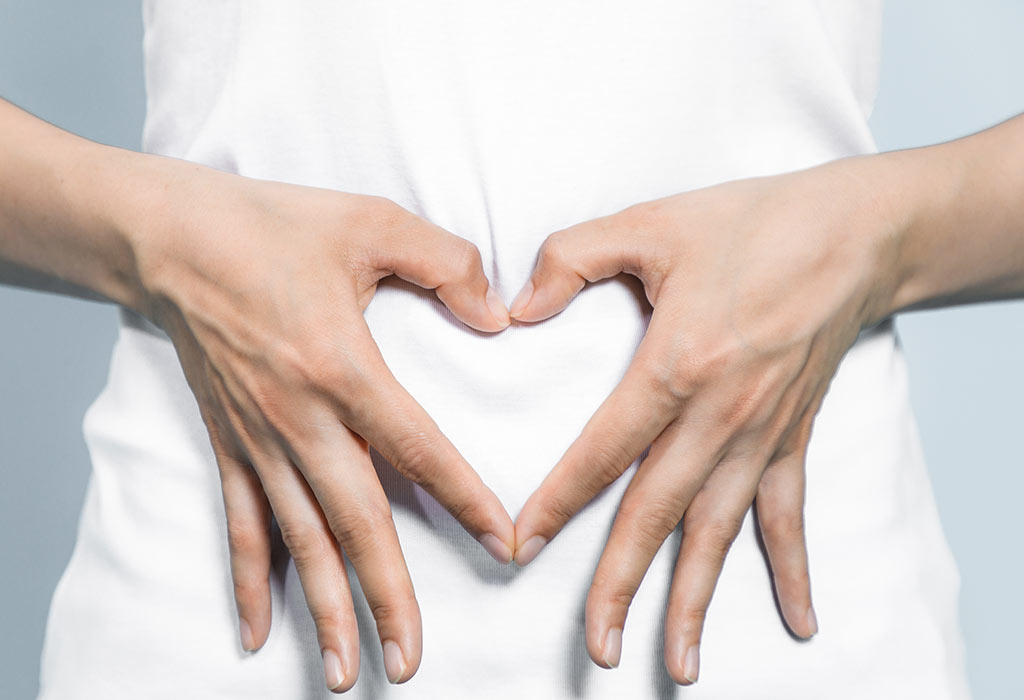- Traumatic vaginal birth
- Use of forceps or vacuum delivery
- Prolonged pushing
- Pelvic floor strain and loosened ligaments
- Vaginal bruising or hematoma
- Complications from an episiotomy
Tailbone (Coccyx) Pain While Pregnant: Causes, Symptoms & Treatments
Medically Reviewed By
Dr. Rima Sonpal
(Gynecologist/Obstetrician)

Motherhood is an experience that comes with its fair share of joys and pain. Taking care of the life growing inside you can be surreal, but many women go through pregnancy with bouts of pain and discomfort. One such pain that almost all women experience is coccyx pain in pregnancy, which is caused due to excessive or irregular pressure on the tailbone.
Tailbone pain during pregnancy can vary in intensity and can be attributed to a combination of hormonal changes, weight gain, and shifts in posture. Understanding the causes, symptoms, and potential relief measures for tailbone pain during pregnancy is essential for ensuring the well-being and comfort of expectant mothers.
What Is Tailbone Pain?
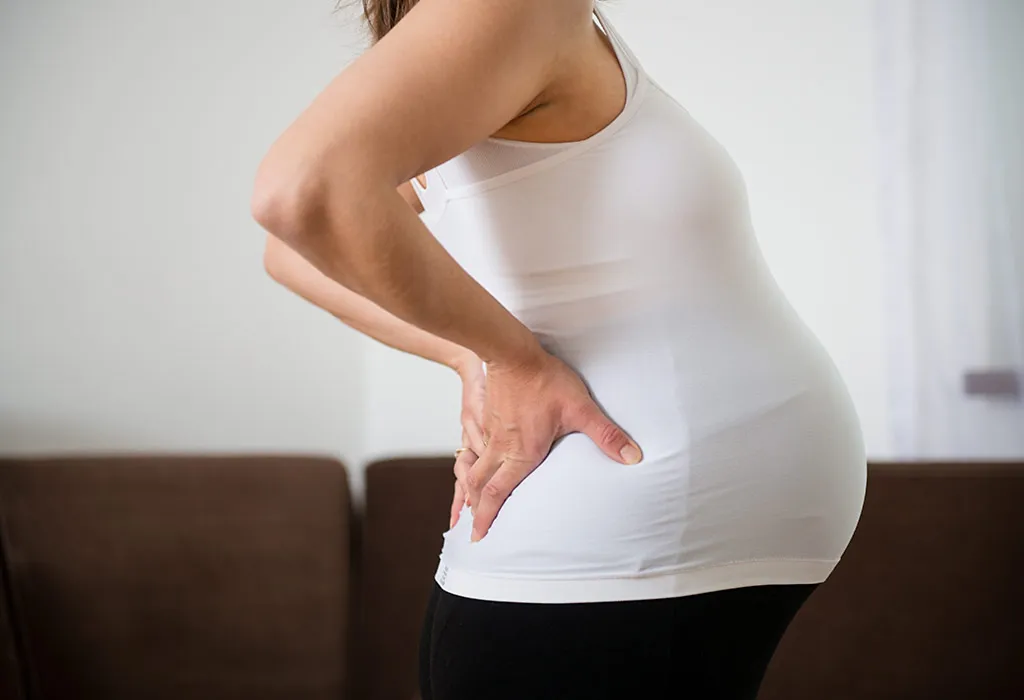
Many pregnant women complain of backaches or aches in the pelvic region. These are just different types of coccyx pain. The pain in the tailbone during pregnancy is the most common type of pain experienced. As the weeks progress, the foetus grows. This increases the pressure in the lower extremities, resulting in aches.
It is perfectly normal to experience pain in the tailbone or coccyx during pregnancy, as it is obvious that as the months pass by, the baby will grow in size and push against the tailbone located at the end of the spine, just behind the uterus. This act of pushing will result in a certain degree of pain, which is most likely to increase in the months leading up to delivery. In some case, the pain will continue after delivery as well (1).
When Does Tailbone Pain Begin During Pregnancy?
Coccyx bone pain during pregnancy can start as early as the first trimester due to hormonal changes but is most common in the third trimesters as the growing uterus and shifting posture put more pressure on the coccyx.
What Causes Tailbone Pain in Pregnant Women?
Are you wondering why your tailbone hurts when pregnant? Coccydynia during pregnancy is common, and here are some of the main reasons it happens.
1. Pregnancy Hormones
During the first trimester, the body releases relaxin and estrogen, which are responsible for causing relaxation in the pelvic region. The ligaments in the abdominal area create a place for the baby by stretching, which results in pain (1).
2. Growing Baby
The baby grows with each passing month. During the second and third trimesters, the baby starts to push against the tailbone, which is just behind the uterus. This act of pushing by the baby results in pain, which keeps increasing until delivery.
3. Other Causes
During the final stages of pregnancy, the baby is fully pressed against the tailbone and is applying a lot of pressure on the bone. Even the slightest irregularity can put pressure on the tailbone, resulting in pain. Any activity in which the body does physical work, like walking, cycling, sitting or even standing can cause pain, and one must be very careful during this stage while doing anything as it is a critical time (2).
Symptoms of Pain in Tailbone During Pregnancy
The symptoms of pain in the tailbone during pregnancy are easy to interpret. Since pain is also a physical sensation, it is bound to be noticed by the brain. Some of the symptoms related to coccyx pain during pregnancy include (3):
- Gradually increasing pain near the end of the spine.
- Sharp and dull pain near the upper buttocks.
- Pain increases or decreases along with the change in posture.
- Constant pain in the lower back or in the hip.
- Pain while walking, climbing, getting up, and twisting.
- The pain gets worse with constipation.
- The pain eases when some physical activity is done.
Risk Factors of Tailbone Pain During Pregnancy
Following are some of the risk factors behind tailbone pain when pregnant:
- Symphysis pubis dysfunction (SPD) (4)
- Constipation
- Lower back injury (herniated disc, sciatica, etc.) (5)
- Pregnancy weight gain
- Tight hamstrings
Conditions That Can Intensify Tailbone Pain When Pregnant
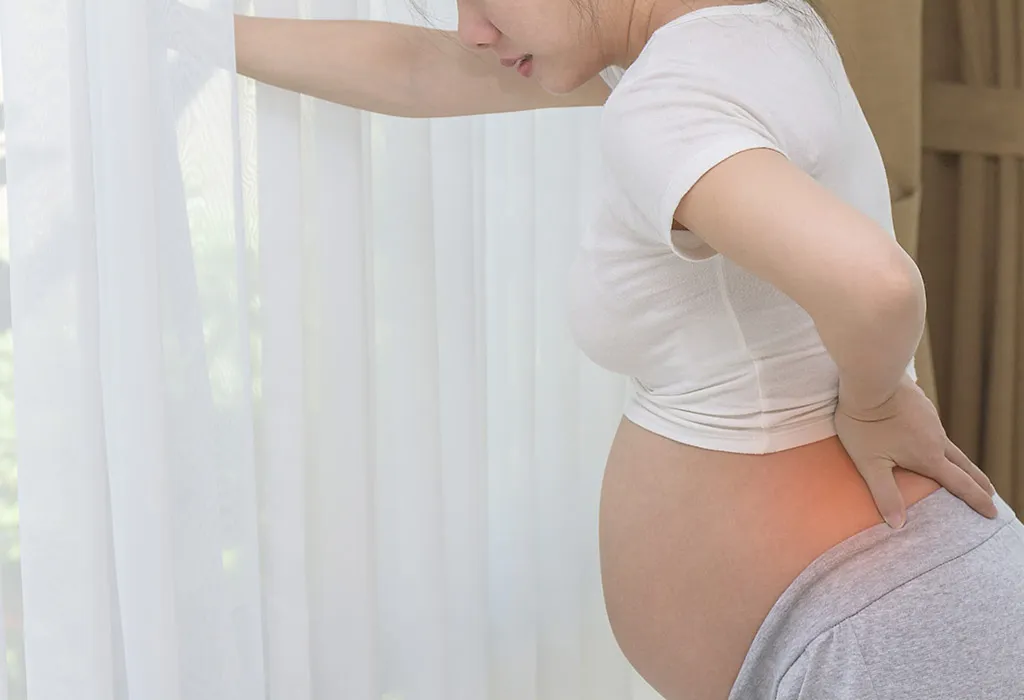
There are several factors on which the severity of the pain depends. One must keep these things in mind before accidentally indulging in something negligent as it can cause problems in the baby’s initial years. We have listed a few causes that can trigger or aggravate coccyx pain.
- Hypermobility: If a woman moves too much during pregnancy without any rest, there is a chance that stress will develop in the tailbone, resulting in pain.
- Limited mobility: If a woman stays in the same position for a long period of time, the pressure on the tailbone increases and causes pain in the area.
- Repetitive stress: If the tailbone has been injured previously and stress is applied to it repeatedly, there is a chance that the pain will increase substantially.
- Infection: Any infection that affects the tailbone can cause more pain.
- Obesity: A woman suffering from obesity has a greater chance of developing a serious case of coccyx pain, as the load on the bones increases due to the fat, which may result in an increase in the pain.
Exercises and Stretches to Get Relief From Tailbone Pain
Following are the stretches and exercises for tailbone pain during pregnancy:
1. Swimming
Swimming has always been a great exercise, and it can act as a remedy against tailbone pain during pregnancy.

2. Yoga
Yoga puts both the mind and body at ease and infuses the body with a different form of energy that can help fight different levels of pain. Yoga makes sure that the blood circulation inside the body takes place effectively and both mom and baby get the blood they need for healthy growth.

3. Pelvic Tilts
Pelvic tilts can help alleviate pregnant tailbone pain by gently engaging and stretching the muscles in the lower back and pelvic region (2). Lie on your back with your knees bent and feet flat on the floor. Slowly tilt your pelvis upward by pressing your lower back into the floor, then release. Repeat this movement several times to relieve tension in the tailbone area.
4. Cat-Cow Stretch
The cat-cow stretch is a gentle yoga pose that promotes flexibility and relieves lower back and tailbone discomfort (6). Begin on your hands and knees in a tabletop position. Inhale as you arch your back and lift your tailbone (cow pose), then exhale as you round your back and tuck your chin to your chest (cat pose). Repeat these movements in a flowing motion to alleviate the pressure of pregnancy tailbone stretches.

5. Seated Forward Bend
This stretch can help release tension in the lower back and tailbone. Sit on the floor with your legs extended in front of you. Gently hinge at your hips and reach forward, aiming to touch your toes or shins. Avoid straining and focus on a gentle stretch. Hold the stretch for a few breaths and then release.

6. Prenatal Yoga Child’s Pose
Modified for pregnancy, the child’s pose provides relief by gently stretching the back and tailbone. Start on your hands and knees, then spread your knees apart to create space for your belly. Sit back on your heels and extend your arms forward, lowering your chest towards the ground. This allows for a soothing stretch along the spine and tailbone area.
7. Hip Flexor Stretch
Tight hip flexor muscles can contribute to tailbone pain. Kneel on one knee and extend the other leg forward at a 90-degree angle. Gently press your hips forward while keeping your back straight, feeling a stretch along the front of the hip. Switch sides and repeat the stretch to alleviate any tension in the pelvic and tailbone region.
How to Relieve Tailbone Pain During Pregnancy – Treatment & Tips
Small steps taken with precaution and regularity can help the mother-to-be deal with tailbone pain in an effective way. During pregnancy, even the smallest lifestyle changes can have lasting effects. Because the pain in the tailbone increases with time, you must know about the common practices you can introduce in your daily life in order to deal with the pain in a safe and effective way. We have a list of practices you can introduce in your day-to-day life to tackle coccyx pain in pregnancy.
1. Use Special Cushions
You must make sure that the tailbone does not rest against any hard surface. You can use a special type of pillow for the same, as it reduces the pressure on the tailbone during pregnancy (1).
2. Avoid Sitting in the Same Position for a Long Period of Time
Try to be in constant motion and avoid being in the same posture for a long period of time. Taking a walk or doing some light exercises can prove to be quite effective (3).
3. Apply Heating Pads
Even though there is no evidence to prove it, heating pads can be quite effective in easing the pain. Heating pads regulate blood supply in the region and prevent the formation of blood clots that can cause additional pain. However, make sure not to overheat the pads, as it can cause discomfort and burns (2).

4. Adjust Your Sleeping Position
Your sleeping position during pregnancy can cause a lot of difference, and you must pay attention to it. If you have a habit of sleeping on your back, you should look into changing your sleeping position as it can create unnecessary pressure on your tailbone. It is advisable to sleep on your left side as it relieves pain and improves blood circulation.
5. Avoid Bending
You must refrain from bending, as it can thrust the baby further toward the tailbone, causing more pain. The pain can be very sharp and sudden, taking one by surprise.
6. Don’t Wear High-heeled Shoes
You should wear flat-soled footwear during pregnancy to reduce the tailbone pain (7).
7. Mild Painkillers
You may have instances where the pain gets too intense and you may find it hard to deal with the pain. In such a scenario, it is advisable to talk to your doctor regarding painkillers. Do not self-medicate at any point of time, especially during pregnancy (3).
8. Relieve Your Bowels
It may sound silly, but this simple practice can make a huge difference (8).
9. Avoid Jerky Movements
Avoid any sudden movements that may take the body by surprise (7).
11. Use a Maternity Support Belt
Wearing a maternity support belt can relieve pressure on the lower back and belly while resting or hanging out with friends at home.
12. Try Prenatal Massages
The prenatal massages can work out those knots in your muscles that are inducing pain while putting no pressure on the tailbone.
13. Lye on Your Side With a Pillow Between the Knees
This can help improve circulation to the tailbone area and will also help to stretch out the surrounding ligaments and muscles (8).
Is Tailbone Pain Curable?
Coccyx pain or the pain in the tailbone during pregnancy is mostly unavoidable, as a woman’s body is naturally making room for the baby to grow. As the baby grows, it pushes against the bones and causes pain. Then, the hormone, relaxin, gets secreted and the bones shift – causing a certain level of discomfort. These phenomena taking place in the body are necessary as they prepare the body for the actual delivery. During the delivery, the tailbone is under immense pressure – this pain subsides only after a few months. If the pain persists even after a few months have passed, it is advisable to consult a physiotherapist.
While tailbone pain is inevitable, it is also a necessary evil that helps prepare a woman for delivery. The body produces the hormone relaxin which is a natural painkiller to reduce the stress a woman’s body goes through during pregnancy (9). While having this pain may feel overwhelming, one can easily manage the pain through regular exercise and by maintaining a healthy lifestyle. The good news is that the pain will eventually subside after pregnancy.
When to Call the Doctor?
Bringing up any discomfort with your doctor during your upcoming appointment is a wise course of action. However, if your tailbone hurts during pregnancy on a daily basis, if it hinders your regular activities, or if it reaches a level of extreme discomfort, reach out to your doctor sooner rather than later (3) (6).
Is Tailbone Pain Normal After Delivery?
Many women experience coccyx pain after childbirth, and this is often connected to what happens during delivery (9). The pain can stem from several factors, such as:
FAQs
1. What makes tailbone pain worse?
Sitting for extended periods, suddenly standing, or lifting heavy objects can worsen tailbone pain. Poor posture and lack of pelvic support can make it even more uncomfortable.
2. Does tailbone pain indicate a problem with the baby?
No, coccyx pain is a normal part of pregnancy and usually doesn’t indicate any issues with the baby’s health.
Pregnancy is a special time in a woman’s life, and it’s important to take extra care to stay healthy and comfortable. Small changes in diet and daily routine, adopting the right sleeping positions, and maintaining a gentle exercise routine can help manage tailbone pain and pregnancy. Doctors also recommend that pregnant women follow a consciously healthy lifestyle throughout this period.
Also Read:
Rib Pain in Pregnancy
Hip Pain while Pregnant
Lower Back Pain when Pregnant
Upper Back Pain During Pregnancy
Was This Article Helpful?
1. Cleveland Clinic – Tailbone Pain (Coccydynia)
2. National Library of Medicine – Coccyx Pain
3. NHS – Tailbone (coccyx) pain
5. Harvard Health Publishing – Herniated disc
6. Nix Health Care – Coccyx Pain Causes And Treatment The Complete Guide
7. Cedars Sinai – Back Pain During Pregnancy
8. Royal Berkshire Hospital – Coccyx pain during pregnancy (antenatal)






